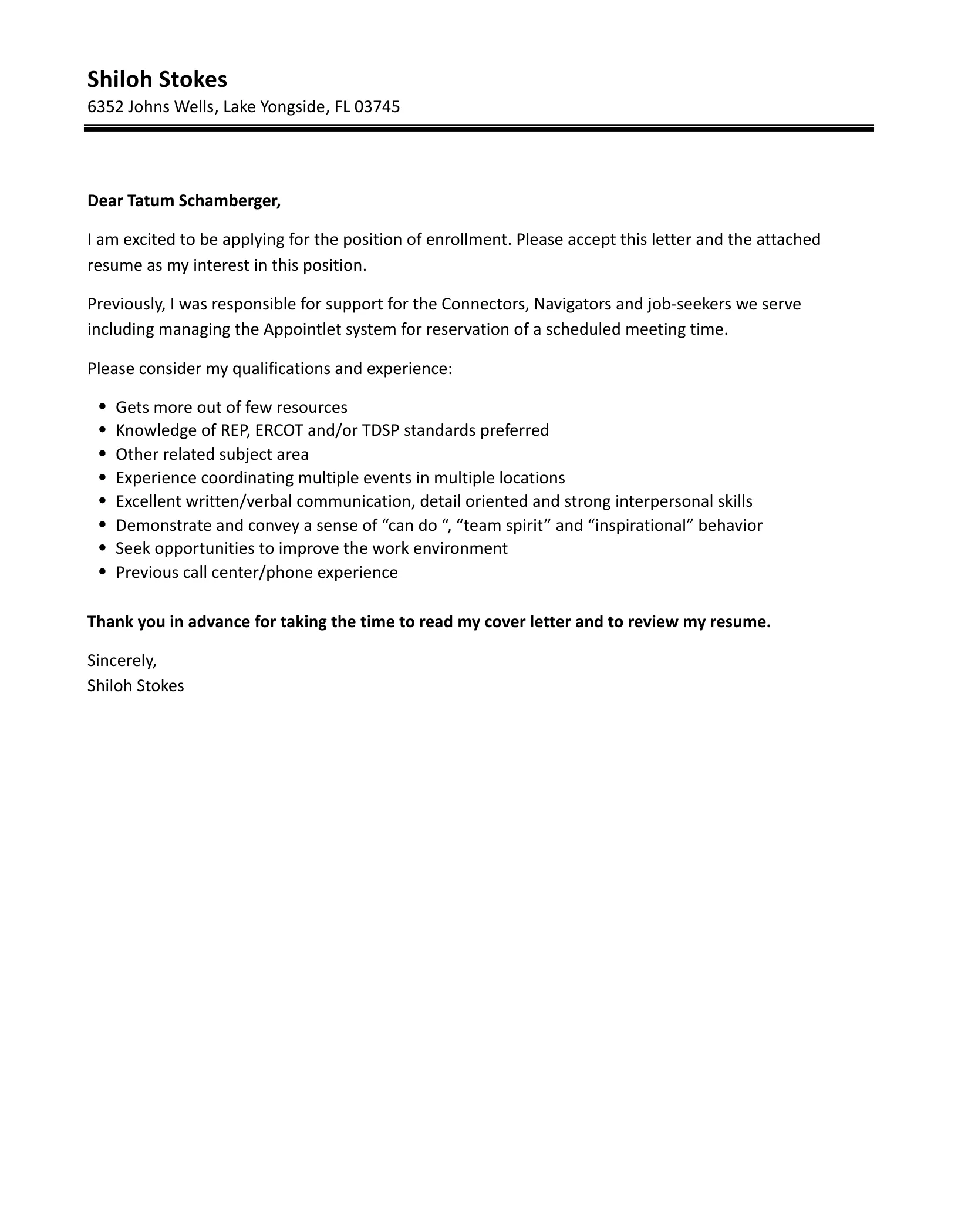What is an Enrollment Specialist?
An Enrollment Specialist plays a crucial role in the education, healthcare, and insurance sectors. They are primarily responsible for guiding prospective students, patients, or clients through the enrollment process. This involves providing information, answering questions, and assisting with the completion of necessary paperwork. The ultimate goal is to facilitate a smooth and efficient enrollment experience, ensuring that individuals can successfully access the services or programs they need. Their responsibilities often include handling inquiries, managing applications, and maintaining accurate records. Effective communication, strong organizational skills, and a customer-centric approach are essential qualities for success in this role.
Key Responsibilities of an Enrollment Specialist
Enrollment Specialists have a diverse range of responsibilities. They typically assess applicant eligibility based on established criteria, provide detailed program information, and address any concerns or queries. This involves explaining policies, procedures, and requirements to potential enrollees. They also assist with the completion and verification of application forms and supporting documents. Moreover, Enrollment Specialists often maintain accurate records of enrollment data, manage applicant files, and coordinate with various departments to ensure a seamless onboarding process. They must possess excellent interpersonal skills to build rapport with applicants and provide exceptional customer service. This role requires the ability to handle sensitive information with confidentiality and to follow strict compliance guidelines.
Crafting Your Enrollment Specialist Cover Letter
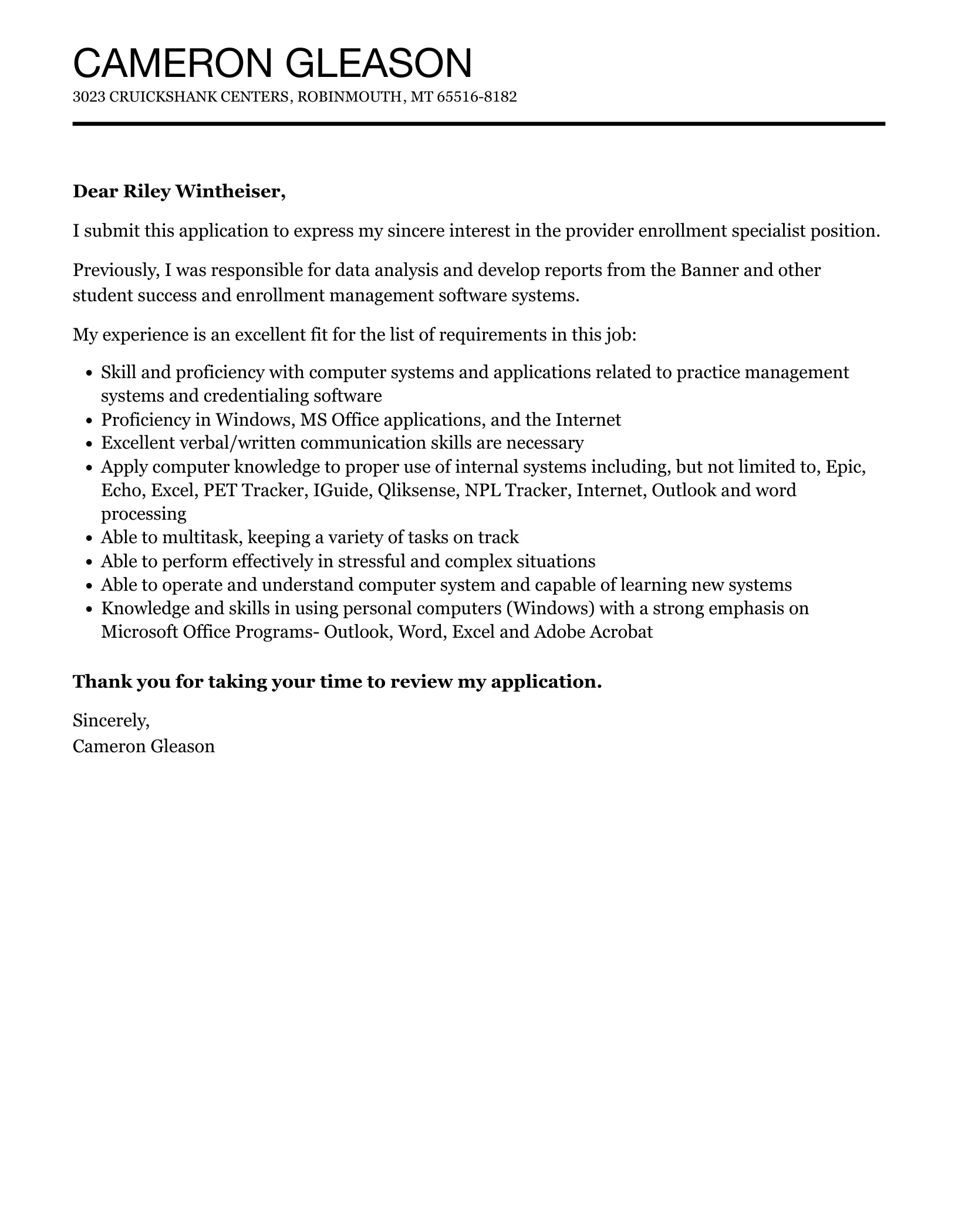
A well-crafted cover letter is a critical component of a successful job application, serving as a personalized introduction that showcases your qualifications and enthusiasm for the role. When applying for an Enrollment Specialist position, your cover letter offers the opportunity to highlight relevant skills, experience, and your understanding of the responsibilities involved. It’s your chance to make a strong first impression and distinguish yourself from other candidates. By following a structured approach and paying attention to detail, you can create a cover letter that effectively communicates your value and increases your chances of securing an interview. The aim is to demonstrate why you are the ideal fit for the organization and the specific role you are targeting.
Header Section
The header sets the professional tone of your cover letter and should include your contact information and the date. Proper formatting is vital here to make sure your letter is easy to read and looks professional. This section also provides the hiring manager with the necessary information to contact you promptly. Ensuring the header is accurate and well-organized reflects your attention to detail and organizational skills, two qualities highly valued in an Enrollment Specialist.
Applicant’s Contact Information
Begin by including your full name, address, phone number, and email address. Ensure the email address is professional. Double-check that all information is correct to avoid any communication issues.
Date
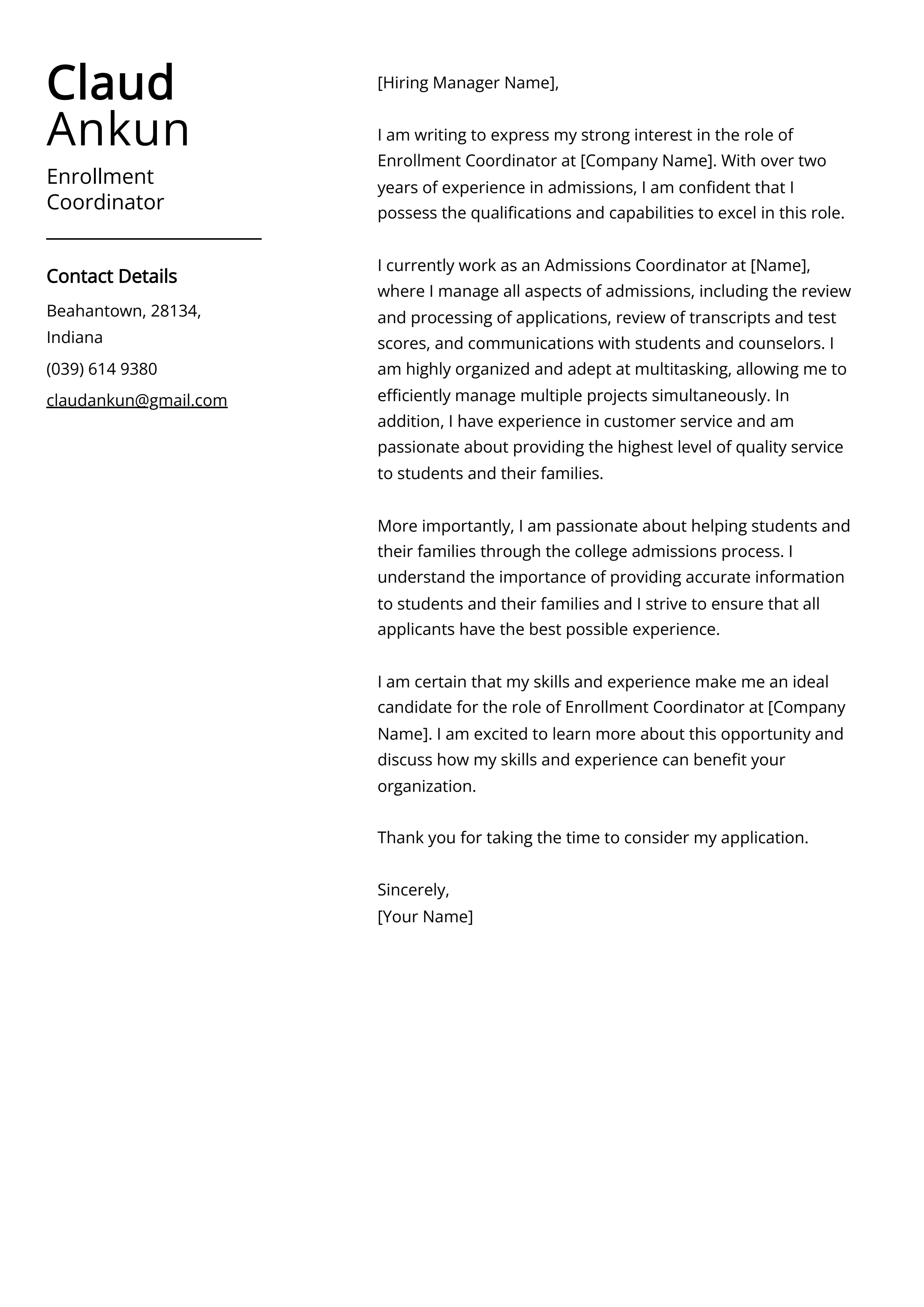
Include the date you are submitting your cover letter. This usually appears below your contact information.
Hiring Manager’s Contact Information
If possible, address the hiring manager by name. If not, use the title of the position or department. Include the company’s name and address to maintain professionalism.
Salutation
Use a formal salutation, such as “Dear Mr./Ms./Mx. [Last Name]” if you know the hiring manager’s name. Otherwise, use a professional greeting like “Dear Hiring Manager.” This shows respect and attention to detail.
Body Paragraphs
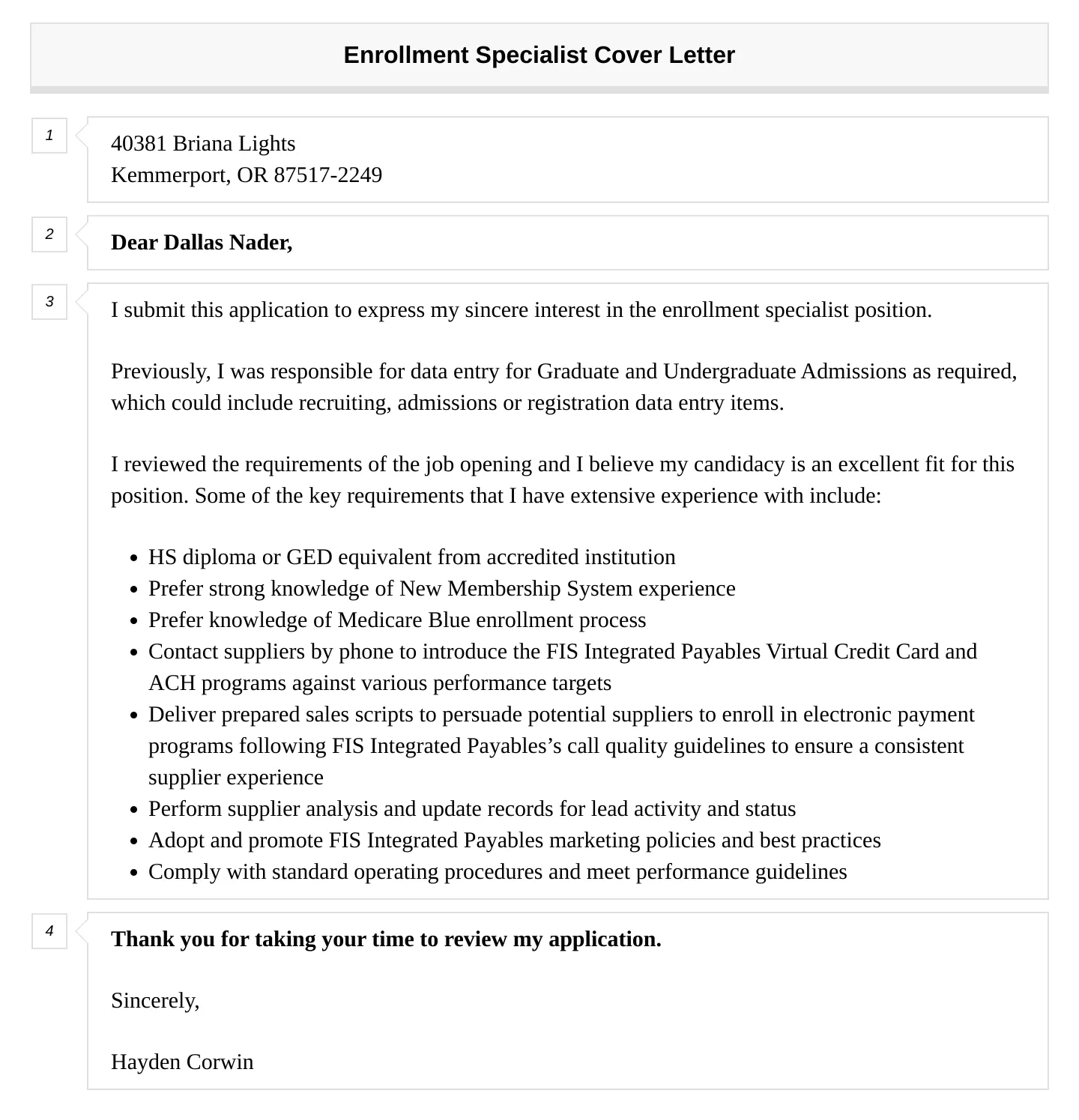
The body of your cover letter is where you truly highlight your qualifications. This section comprises several paragraphs, each serving a specific purpose in presenting your skills and experiences effectively. The goal is to clearly and concisely explain why you are the best candidate for the Enrollment Specialist position. Focus on matching your skills and experience to the job description and demonstrating your understanding of the role’s requirements. Well-structured body paragraphs make your cover letter easy to read and leave a lasting positive impression.
Paragraph 1: Expressing Interest and Highlighting Skills
Start by expressing your enthusiasm for the position and the company. Briefly mention where you saw the job posting. Immediately highlight your most relevant skills that align with the job requirements. This creates a strong initial impression, indicating that you understand the role and have the capabilities to excel. Emphasize your ability to manage applicant inquiries, handle sensitive information, and provide excellent customer service, which are key to enrollment specialists. Show your eagerness to contribute to the organization’s success.
Paragraph 2: Showcasing Relevant Experience and Achievements
Detail your experience in enrollment, customer service, or related fields. Use specific examples to quantify your accomplishments and illustrate your abilities. Instead of just listing your responsibilities, describe your achievements using the STAR method (Situation, Task, Action, Result). For instance, describe how you improved enrollment rates, streamlined processes, or reduced errors. Providing concrete examples of your successes demonstrates your value and highlights your potential contributions. If you have experience with any specific software or databases relevant to enrollment management, be sure to mention them.
Paragraph 3: Demonstrating Passion and Company Alignment
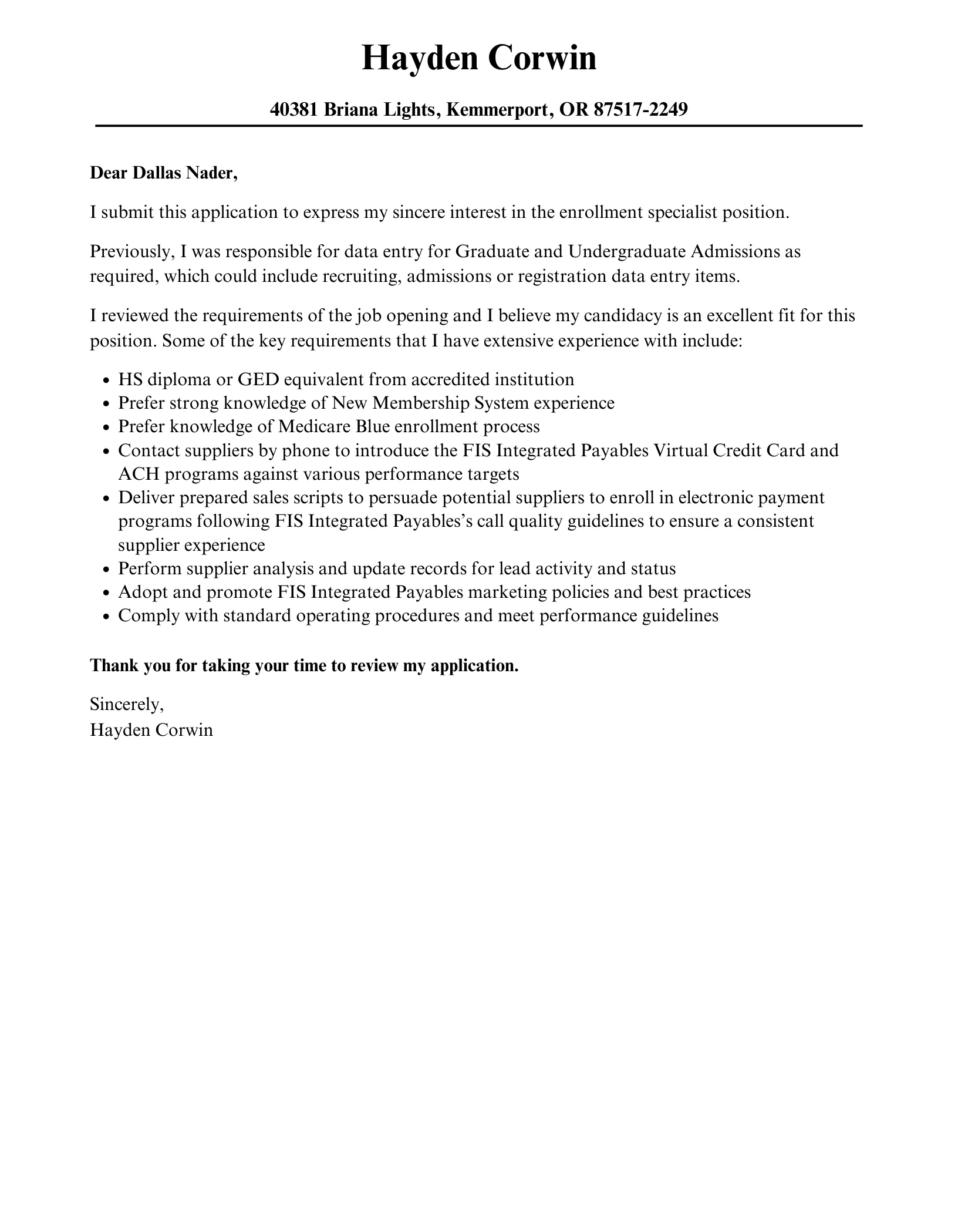
Express your passion for the organization and the role. Demonstrate that you’ve researched the company and understand its mission and values. Explain how your skills and experiences align with the organization’s goals. Mention any specific projects or initiatives that resonate with you. This shows your genuine interest and makes you stand out from other applicants. Highlighting your company alignment underscores your commitment to the position, reinforcing your suitability for the role and demonstrating your potential to become a valuable team member.
Call to Action
Encourage the hiring manager to contact you. Express your availability for an interview and reiterate your enthusiasm for the position. Thank them for their time and consideration, showing professionalism and respect.
Closing the Letter
Conclude your cover letter with a professional closing and your typed name. This provides a polished and formal finish, leaving a positive impression on the hiring manager. Ensure all elements of the closing are correct to maintain the tone and effectiveness of your application.
Formal Closing

Use a professional closing such as “Sincerely,” “Respectfully,” or “Best regards.” Avoid casual closings like “Thanks” or “Cheers” as they may be seen as unprofessional.
Typed Name
Type your full name below the closing. This provides a clear and easy-to-read signature.
Proofreading and Formatting
A cover letter filled with errors can significantly diminish your credibility. Proofreading ensures that your message is clear, concise, and free from mistakes. Formatting contributes to a professional appearance, making your cover letter easy to read. Taking the time to proofread and format your cover letter is a simple step that can make a big difference in how it is perceived. It demonstrates your attention to detail, organizational skills, and commitment to excellence, all valuable attributes for an Enrollment Specialist.
Reviewing and Editing Your Cover Letter

Review your cover letter multiple times, checking for grammatical errors, spelling mistakes, and punctuation issues. Read your cover letter aloud to catch awkward phrasing or unclear sentences. Ask a friend or family member to review it as well; a fresh pair of eyes can often spot errors you may have missed. Ensure the tone is professional and the content is relevant to the job requirements. Each review adds a layer of polish, making your application more compelling and demonstrating your thoroughness.
Formatting Guidelines for Cover Letters
Choose a professional font such as Times New Roman, Arial, or Calibri, with a font size between 10 and 12 points. Use single-spaced lines with a space between each paragraph. Keep the margins at 1 inch on all sides. Ensure the alignment is consistent, either left-aligned or justified. Proper formatting makes your cover letter visually appealing and easy to read, which increases its impact. Consistent formatting presents you as organized and detail-oriented, qualities employers seek.
Tailoring Your Cover Letter
Customizing your cover letter for each application increases your chances of success. This involves tailoring your content to the specific requirements and culture of each company. A generic cover letter can easily be overlooked, whereas a customized one shows that you’ve taken the time to understand the position and the organization. This level of personalization demonstrates genuine interest and significantly enhances your application.
Researching the Company
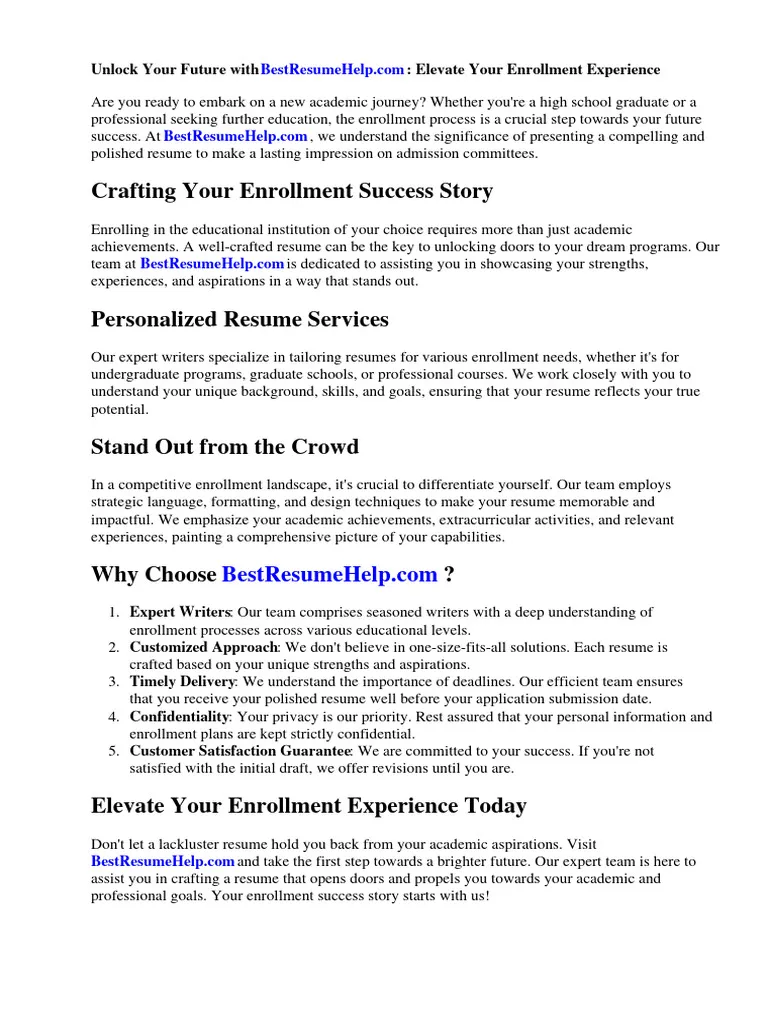
Before writing, research the company thoroughly. Visit their website, social media profiles, and read news articles. Understand their mission, values, and recent achievements. This knowledge allows you to personalize your cover letter, demonstrating that you’ve gone beyond simply applying for a job. Use this information to align your skills and experiences with the company’s objectives, showing a genuine interest in their success.
Highlighting Specific Skills and Experiences
Carefully review the job description and identify the key skills and experiences the employer is seeking. Use these keywords and phrases in your cover letter to highlight your relevant qualifications. Provide specific examples of how you’ve used these skills in previous roles, showing how you meet the requirements. Highlighting specific skills and experiences demonstrates that you understand the role and can effectively perform the necessary tasks, greatly increasing your chances of securing an interview.
Using Action Verbs
Use action verbs to describe your accomplishments and responsibilities. This adds impact and makes your cover letter more engaging. Start sentences with strong action verbs to showcase your abilities. Examples include “managed,” “coordinated,” “implemented,” “resolved,” “achieved,” and “improved.” Using action verbs creates a dynamic picture of your past performance and provides concrete evidence of your achievements, making your application more compelling and memorable.
Sample Cover Letter: Enrollment Specialist
While a custom cover letter is best, a sample cover letter provides a strong foundation. Reviewing sample letters can help you grasp the structure and tone expected for this role. Adapt the examples to fit your specific qualifications and the job requirements. Remember to tailor the language, examples, and achievements to align with your own experience. Utilize these samples to gain clarity on what information is essential to include in your personal cover letter. Referencing a sample allows you to develop a more persuasive and successful application.
Example Cover Letter Structure
Follow the standard structure of a professional cover letter. This includes the header, salutation, body paragraphs, a call to action, and closing. Ensure that the information is presented logically and clearly. This organizational strategy enhances readability and maximizes the impact of your message. A well-structured cover letter exhibits professionalism and strengthens your application, making you appear as a more organized and qualified candidate.
Cover Letter Template for Enrollment Specialist
Use a template to streamline the writing process. This provides a pre-formatted structure and a guide for what content to include in each section. Numerous templates are available online, and they provide a starting point that can be customized to highlight your unique skills and experiences. Employing a template saves you time and reduces the likelihood of overlooking vital information. These templates serve as a valuable tool for creating a professional and effective cover letter, increasing your chances of securing an interview.
Common Mistakes to Avoid
Avoiding common mistakes is crucial to making a strong impression on hiring managers. Ensure your application is free of errors by reviewing it thoroughly. Correcting these mistakes is essential to make your application more appealing. Addressing common errors reflects your attention to detail and increases the likelihood of your application being considered.
Generic Cover Letters
Avoid using a generic cover letter. Such letters fail to highlight your unique skills or address the specific requirements of the job. Customize each cover letter for the target position. Tailoring the letter makes the applicant’s genuine interest and suitability clear. Addressing the specific needs of the role helps set you apart.
Typos and Grammatical Errors
Always proofread your cover letter carefully for typos, grammatical errors, and punctuation mistakes. Errors create a negative impression and make you look less professional. Proofreading helps ensure that your message is clear and effective, so take the time to review the document before submitting it. Proofreading and editing is a must.
Lack of Customization
Do not send a cover letter that does not reflect the company’s requirements or your understanding of the role. This can be addressed by conducting research about the company before writing your cover letter. Customize the letter so that it resonates with the company’s culture and values. Tailoring your letter to match the specific job makes your application more compelling and shows the hiring manager that you have taken the time to understand their needs.
Insufficient Information
Provide enough details about your skills, experiences, and accomplishments. Ensure you are not too brief in your writing. Include specific examples to illustrate your capabilities and demonstrate the value you bring to the position. Offering adequate information makes you appear as a well-qualified candidate. Providing thorough information is also helpful to the hiring manager as they evaluate your potential suitability for the role.
Finalizing and Submitting Your Cover Letter
After writing and editing your cover letter, it’s time to finalize and submit your application. This involves formatting the letter for submission, ensuring you’ve included all necessary attachments, and submitting it through the appropriate channels. This part of the application process represents your opportunity to submit a polished application. Proper attention to detail and adherence to guidelines help improve your chances of getting the job.
Preparing for the Application Process
Save your cover letter in a professional format, such as PDF. Review the job application instructions carefully to ensure you are meeting all requirements. Submit your cover letter and resume in the requested manner and follow any specified guidelines. This makes the hiring manager know that you are capable of following instructions. Confirm all the attachments and information are included.
By following these guidelines and tailoring your Enrollment Specialist cover letter, you can increase your chances of landing an interview and securing your desired position. Good luck!
